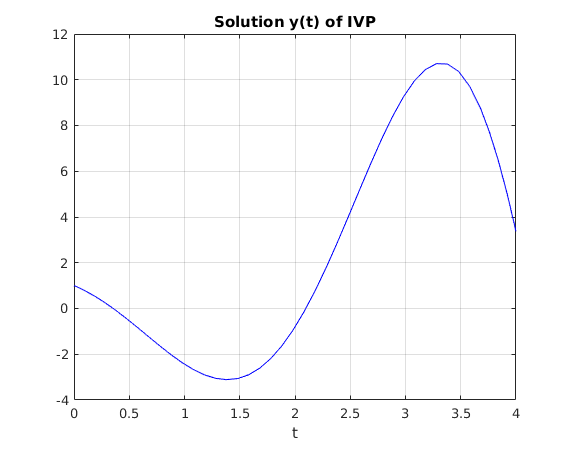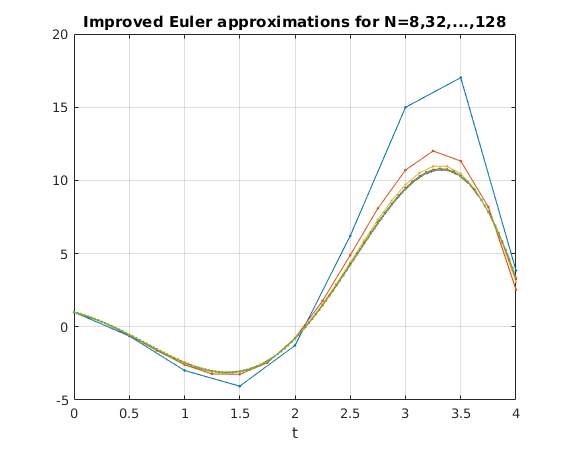Solving a 2nd order ODE with the Improved Euler method
Contents
Initial value problem
We consider an initial value problem for a 2nd order ODE:

and we want to find the solution y(t) for t in [0,4].
We first have to rewrite this as a 1st order system: Let  and
and  , then we obtain
, then we obtain
![$$\left[\begin{array}{c}y_1' \\ y_2'\end{array}\right] = \left[\begin{array}{c}y_2 \\ t+y_2-3y_1\end{array}\right], \qquad \left[\begin{array}{c}y_1(0) \\ y_2(0)\end{array}\right] = \left[\begin{array}{c} 1\\ -2\end{array}\right]$$](Ieuler_demo2_eq01437485964095730209.png)
Now we can define a vector valued function f(t,y) and an initial vector y0.
We use ode45 to find the solution of the initial value problem. At the final time T we obtain the approximation yfin = [y1fin,y2fin] for ![$[y(T),y'(T)]$](Ieuler_demo2_eq01840412256881501397.png) .
.
We plot the solution  .
.
function Ieuler_demo2
f = @(t,y) [y(2); t+y(2)-3*y(1)]; % define function f(t,y) t0 = 0; y0 = [1;-2]; % initial condition with vector y0 T = 4; % final t-value [ts,ys] = ode45(f,[t0,T],y0); % solve IVP yfinal = ys(end,:); % approximations for y1(T),y2(T) fprintf('y(T) = %g, y''(T) = %g\n',ys(end,1),ys(end,2)) plot(ts,ys(:,1),'b'); hold on % plot solution y(t) title('Solution y(t) of IVP') xlabel('t'); grid on
y(T) = 3.36902, y'(T) = -21.7257

Use Improved Euler method with N=8,16,32,...,128
We see that the Euler approximations get closer to the correct value as N increases.
When we double the value of N the error gets divided by about 4. This means that the error is bounded by  : The Euler method converges with order
: The Euler method converges with order  .
.
olderr = NaN; for N = 2.^(3:7) [ts,ys] = IEuler(f,[t0,T],y0,N); err = norm(ys(end,:)-yfinal); % norm of error fprintf('N = %3g, y(T) = [%10g,%10g], ||error|| = %10g, quotient = %g\n',N,ys(end,:),err,olderr/err) olderr = err; plot(ts,ys(:,1),'.-') % plot Euler approximaton for y1 (1st column of ys) end hold off title('Improved Euler approximations for N=8,32,...,128')
N = 8, y(T) = [ 3.84777, -44.0519], ||error|| = 22.3314, quotient = NaN N = 16, y(T) = [ 2.5381, -26.9189], ||error|| = 5.25928, quotient = 4.2461 N = 32, y(T) = [ 3.07319, -22.9907], ||error|| = 1.29912, quotient = 4.04833 N = 64, y(T) = [ 3.28324, -22.0368], ||error|| = 0.322733, quotient = 4.02538 N = 128, y(T) = [ 3.34614, -21.7992], ||error|| = 0.0770437, quotient = 4.18896

Code of function IEuler(f,[t0,T],y0,N)
At each step we evaluate the slope twice: first at the current point, then at the Euler approximation. We then use the mean (s1+s2)/2 to find the new y value.
function [ts,ys] = IEuler(f,tv,y0,N); t0 = tv(1); T = tv(2); h = (T-t0)/N; % stepsize h ts = zeros(N+1,1); ys = zeros(N+1,length(y0)); t = t0; y = y0; % initial point ts(1) = t; ys(1,:) = y'; for i=1:N s1 = f(t,y); % evaluate direction field at current point yE = y + s1*h; % find Euler value yE s2 = f(t+h,yE); % evaluate direction field at Euler point y = y + (s1+s2)/2*h; % use mean (s1+s2)/2 to find new y t = t + h; ts(i+1) = t; ys(i+1,:) = y'; % store y(1),y(2) in row of array ys end end
end